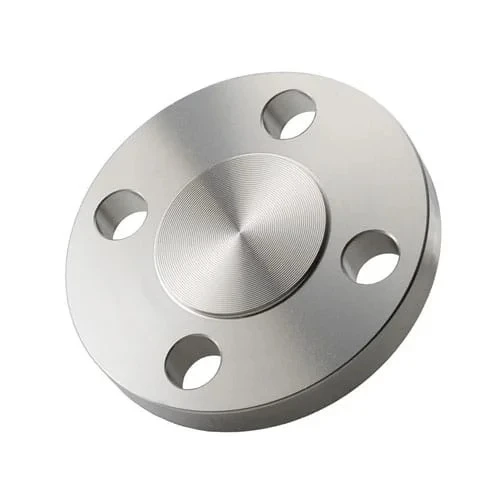When it comes to industrial systems, the selection of flanges plays a crucial role in ensuring the functionality, efficiency, and safety of piping systems. Among the various types of flanges used in high-pressure systems, blind flanges are commonly chosen to seal the ends of pipelines, preventing the passage of fluids and gases. Blind flanges serve as a vital component in the design and maintenance of high-pressure systems, which demand reliability and durability. In this blog, we will explore the key factors you should consider when selecting blind flanges for high-pressure systems, making sure you get the right fit for your specific needs.
What Is a Blind Flange?
A blind flange is a type of flange used to seal the end of a piping system. Unlike other flanges that connect two pipes, a blind flange is designed to close off a pipeline, thus preventing the flow of substances like water, gas, or chemicals. This makes blind flanges especially important in systems where future access may be needed, or in situations where a permanent closure is required without the need for ongoing maintenance.
Blind flanges are used in industries such as oil and gas, petrochemical, water treatment, and power generation, where high-pressure and high-temperature environments are prevalent. These flanges come in various sizes, materials, and pressure ratings to meet the specific demands of different systems.
Importance of Blind Flanges in High-Pressure Systems
High-pressure systems involve the transportation of fluids or gases at elevated pressures. These systems are typically subject to extreme conditions that require components, such as blind flanges, to withstand high stress and pressure. The blind flange’s function is to ensure the integrity of the pipeline, preventing leaks and ensuring safe operation in hazardous environments.
Choosing the correct blind flange for your system is essential, as failure to do so can lead to leaks, system failures, or even catastrophic accidents. The high pressure in these systems creates significant force on the components, meaning they must be made of materials that can handle the stress. Let’s explore the main factors you should consider when selecting blind flanges for high-pressure systems.
1. Material Selection for Blind Flanges
The first and most critical factor when choosing a blind flange for a high-pressure system is selecting the right material. The material should not only be able to withstand high pressure but also be resistant to corrosion, temperature extremes, and chemical reactions, depending on the substance being transported through the pipeline.
Common materials used for manufacturing blind flanges include:
Carbon Steel
Carbon steel is a popular material choice for high-pressure systems due to its strength and durability. It offers good performance in standard environments and is cost-effective. However, it may not be suitable for systems exposed to highly corrosive substances.
Stainless Steel
Stainless steel, especially grades like 304 and 316, is widely used in high-pressure systems that deal with corrosive fluids or gases. The inherent corrosion resistance of stainless steel ensures a longer lifespan and better reliability in systems where corrosion is a concern.
Alloy Steel
For high-temperature and high-pressure applications, alloy steels like ASTM A182 F11 or F22 are commonly used. These materials offer superior strength and resistance to high temperatures and pressure. They are often used in the oil and gas industry.
Duplex and Super Duplex Stainless Steel
For extremely demanding applications, duplex and super duplex stainless steels offer excellent strength and resistance to corrosion. These materials are commonly used in high-pressure and high-temperature environments, such as deep-water drilling or chemical processing systems.
Hastelloy and Inconel
In applications with very high temperatures or highly aggressive chemicals, exotic materials like Hastelloy and Inconel offer unmatched performance. These materials are costly but necessary for highly specialized systems.
When selecting the right material, it's essential to consider the type of fluid or gas, temperature, and pressure levels in your system. Blind flanges made from the wrong material can fail under pressure or degrade over time, leading to expensive repairs or safety hazards.
For more information on the different materials used in flanges, check out our flanges product page.
2. Pressure Rating of the Blind Flange
Pressure rating is one of the most important factors in selecting the right blind flange for a high-pressure system. Pressure ratings are typically denoted by classes such as 150, 300, 600, 900, 1500, and 2500, and they define the maximum pressure that a flange can handle.
A blind flange with an inappropriate pressure rating may not be able to withstand the operational pressures in your system, leading to failure and leaks. It’s essential to choose a blind flange with a pressure rating that matches or exceeds the pressure requirements of your system.
Considerations for Pressure Rating:
- Class 150: Used for low-pressure systems, typically up to 285 psi at room temperature.
- Class 300: Used for medium-pressure systems, typically up to 740 psi.
- Class 600: Used for higher-pressure systems, typically up to 1,480 psi.
- Class 900-2500: Used for very high-pressure systems, up to 2,500 psi and beyond.
It’s crucial to select a blind flange with the correct pressure class to ensure safety and reliability in the system.
3. Temperature Resistance
Temperature is another critical factor when selecting a blind flange for high-pressure systems. Extreme temperatures can cause materials to expand, contract, or even degrade, potentially compromising the seal and safety of the system.
High-Temperature Environments
For systems exposed to high temperatures, such as steam or thermal oil systems, materials like alloy steel, stainless steel, and Inconel should be considered. These materials are engineered to handle thermal stress and maintain their integrity even at elevated temperatures.
Low-Temperature Environments
In low-temperature systems, such as cryogenic systems, materials like carbon steel and stainless steel are often preferred, with additional considerations for brittleness at low temperatures.
Selecting the correct blind flange based on the temperature range of your system ensures that the flange remains effective and durable over time.
4. Flange Size and Compatibility
The size of the blind flange is critical to ensuring it fits perfectly with the pipeline. A flange that is too small or too large for the pipe can cause alignment issues, leaks, or even system failure. Therefore, it’s essential to take precise measurements of the pipe’s diameter, thickness, and flange dimensions.
The most common flange sizes are based on the pipe schedule and pressure class. The dimensions of the flange should match the corresponding pipe dimensions to ensure a tight and secure fit.
Key Considerations for Flange Size:
- Pipe Diameter: The flange must match the nominal pipe size (NPS) and the schedule number of the pipe.
- Bolt Circle Diameter (BCD): Ensure that the bolt circle of the blind flange corresponds with the bolt holes on the pipe.
- Bolt Hole Size: The size and number of bolt holes must match the requirements for the pressure class.
Ensuring the right fit for your blind flange is crucial for a successful and leak-free installation.
5. Corrosion Resistance
Corrosion can lead to the degradation of materials, reducing the lifespan and performance of your blind flange. High-pressure systems often deal with corrosive substances, which can rapidly cause wear and tear on the flange. Therefore, selecting a corrosion-resistant material is essential for maintaining the integrity of the system.
Corrosion Resistance Materials:
- Stainless Steel: Known for its resistance to rust and corrosion, particularly when exposed to wet or acidic environments.
- Duplex Stainless Steel: Offers higher resistance to corrosion than standard stainless steel.
- Nickel Alloys: Materials like Inconel and Hastelloy offer excellent resistance to corrosion in extreme environments.
Choosing the right blind flange material that is resistant to corrosion ensures a long-lasting and safe connection in high-pressure systems.
6. Welding and Installation Process
The installation process of a blind flange should be straightforward and secure to avoid any leaks or operational issues. Depending on the system's design, the flange may need to be welded or bolted into place.
Welding
Welding a blind flange is common in high-pressure systems as it provides a strong and permanent seal. It’s essential to ensure proper welding techniques are used to avoid weak points or cracks in the flange, which could lead to failure.
Bolting
Bolting a blind flange can be done for temporary or removable closures. In high-pressure systems, proper torque must be applied to the bolts to ensure a tight seal and avoid leaks.
Choosing the appropriate installation method based on your system’s requirements is important to maintain pressure and ensure safety.
Conclusion
When selecting blind flanges for high-pressure systems, it’s essential to consider factors like material selection, pressure rating, temperature resistance, flange size, corrosion resistance, and installation methods. Taking the time to choose the right blind flange will ensure the safety, longevity, and efficiency of your piping system.
For more details on blind flanges and to explore a wide range of options, visit our flanges product page.
By understanding the factors that affect flange performance, you can make an informed decision that will meet the demands of your high-pressure system, ensuring reliable operation and safety for years to come.


